|
|
|
Sort Order |
|
|
|
Items / Page
|
|
|
|
|
|
|
| Srl | Item |
| 1 |
ID:
124882
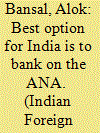

|
|
|
|
|
| Publication |
2013.
|
| Summary/Abstract |
Many analysts perceive that India should evolve a joint strategy with the Central Asian States to counter both the Taliban and Pakistani influence in Kabul. However, this has the grave disadvantage of being perceived as anti-Pakhtoon in Afghanistan's fractured ethnic mosaic. Similarly, any coalition with Iran is likely to be perceived as anti-Sunni by the dominant sect in Afghanistan. In addition, considering the current state of US-Iran relations, any relationship with Iran has a risk of running afoul of the USA. The best option for India is to bank on the ANA and pro-India politicians in Afghanistan. India must not allow it to be side-lined on Afghanistan as was done in the Turkey and London Conferences. There are many Afghan politicians who are willing to do India's bidding.
|
|
|
|
|
|
|
|
|
|
|
|
|
|
|
|
| 2 |
ID:
134081
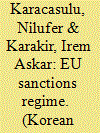

|
|
|
|
|
| Publication |
2014.
|
| Summary/Abstract |
Although there is enormous discussion on normative power Europe, there is relatively less focus on the EU sanctions regime, though sanctions have become a useful foreign policy tool as the EU has applied sanctions within the framework of the Common Foreign and Security Policy. Looking at the literature, Kreutz focused on the EU sanctions regime in the time period of 1981-2004, during which sanctions
were used to accomplish normative goals. Yet, later on Brummer argued that although norms and values still play a role in the EU's sanctions regime, more often they were surpassed by security and economic interests. This article examines the previous work on the EU sanctions regime and tries to comprehend why the use of sanctions has increased over time as well as whether they have been "selectively" used. In addition, the article analyzes whether the normative commitment is crucial in the construction of the EU sanctions regime. The EU sanctions regime toward Iran is analyzed in particular, because as indicated by Santini and Tabrizi, Iran is the first country against which the EU has developed a new strategy out of weapons of mass destruction concerns, starting in 2006. Since 2010, EU foreign ministers have adopted tougher sanctions in an effort to block its controversial nuclear program. Recently, the Iran nuclear deal of November 2013 was interpreted as attributable to sanctions against Iran, in which EU sanctions have constituted a remarkable role, have proven effective.
|
|
|
|
|
|
|
|
|
|
|
|
|
|
|
|
| 3 |
ID:
133858
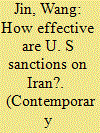

|
|
|
|
|
| Publication |
2014.
|
| Summary/Abstract |
U. S. sanction on Iran have expended since the start of the Iranian nuclear issue. They have grown from small scale embargoes to today's sanctions on multiple sectors including finance, trade, energy and personnel. During U. S. President Barak Obama's tenure, there is very little likelihood that the U. S will resort to force, leaving Washington with no other means than sanctions to persuade Iran to change its nuclear policy. This means that although sanctions have a limited effect, the US will continue primarily rely on them to force Iran's hand.
|
|
|
|
|
|
|
|
|
|
|
|
|
|
|
|
| 4 |
ID:
133523
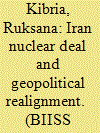

|
|
|
|
|
| Publication |
2014.
|
| Summary/Abstract |
The November 2013 interim nuclear deal that was signed between the P5+1 and Iran is an epochal event, though, given the volatile situation, it may be too early to make a correct prognosis of its ramifications. For one thing, the nuclear deal could complicate the regional security environment by exacerbating Saudi-Iranian tension, though as such, it is not the source. Regardless of Saudi displeasure at the conclusion of the accord, Iran's ascendancy is amply clear, with its ambiguous nuclear status playing a strategic role. While the dominant narrative currently is the centrality of Shia-Sunni regional tension represented by Iran and Saudi Arabia, reality is far more intricate and multi-dimensional, requiring a more nuanced appreciation of their relationship, which suggests that, for the foreseeable future it would be in the US interest to have Saudi Arabia, off-setting Iran, but from a much weaker position, in a replay of the game of balance of power achieved through sustained geopolitical manipulation, and a smaller American foot-print. The goal of Tehran's nuclear brinksmanship is essentially ensuring its regional primacy, which accords with US interests, too. While the recent interim Iran deal apparently concerns the nuclear issue, it has far-reaching implications for the global energy market, which the relaxation of economic sanctions and the integration of Iran as a legitimate member of the international community is certain to affect. US-Iran normalisation of relations is quietly enhancing China's role, both economic and military, in the Gulf region, whose energy resources for the foreseeable future would continue to remain crucial for Beijing. More than a reconciliation between Washington and Tehran, the essence of a real paradigm shift would involve a Saudi-Iranian accommodation, and de facto Saudi acceptance of Iran's regional pre-eminence.
|
|
|
|
|
|
|
|
|
|
|
|
|
|
|
|
| 5 |
ID:
133623
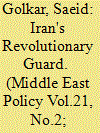

|
|
|
|
|
| Publication |
2014.
|
| Summary/Abstract |
During the past three decades, numerous Western media sources have portrayed Iranians as opposed to the United States, epitomized by a small group shouting "death to America." However, many Westerners who have traveled to Iran have seen a completely different picture, often finding that many Iranians have more positive attitudes.1 Many American visitors have described Iranians as the most pro-American people in the Middle East.2 Deep frustration with the Islamic Republic and mistrust of the clerical establishment's propaganda have made Iranians "avid fans of America: its culture, films, food, music, it's open, free-wheeling society
|
|
|
|
|
|
|
|
|
|
|
|
|
|
|
|
| 6 |
ID:
134083
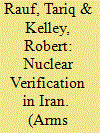

|
|
|
|
|
| Publication |
2014.
|
| Summary/Abstract |
For nearly a year, negotiations on Iran's nuclear program have been underway between Iran and the EU3+3 (China, France, Germany, Russia, the United Kingdom, and the United States).[1] The two sides in the negotiations, which the European Union has facilitated, are seeking a "mutually-agreed long-term comprehensive solution that would ensure Iran's nuclear programme will be exclusively peaceful."[2]
In November 2013, the sides agreed to an arrangement known as the Joint Plan of Action, under which Iran has taken substantial steps to address proliferation concerns about its nuclear activities. In particular, under International Atomic Energy Agency (IAEA) safeguards supplemented by additional IAEA monitoring and verification pursuant to the Joint Plan of Action, Iran has halted the production of uranium enriched to 20 percent uranium-235 and down-blended half its entire stock of that material to below 5 percent U-235 while converting the rest to uranium oxide, which cannot be immediately used for enrichment. In addition, Iran has capped the production of 5 percent-enriched uranium and accepted daily IAEA inspector access at its uranium-enrichment facilities at Natanz and Fordow and monthly access at the under-construction Arak heavy-water reactor, among other measures.[3]
|
|
|
|
|
|
|
|
|
|
|
|
|
|
|
|
| 7 |
ID:
117987
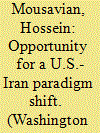

|
|
|
|
|
| Publication |
2013.
|
| Summary/Abstract |
The Arab region today is drenched in chaos and instability: Palestine is bleeding, Iraq burning, Syria erupting, Persian Gulf oil countries are trembling, Lebanon simmering, Afghanistan devastated, and Iran under adversarial focus. An array of unaddressed historical grievances and unresolved disputes add to this chaos. Starting with Tunisia last year, the Arab Street has virtually been under popular siege to break away from long-brewing political morbidity and authoritarian culture.
|
|
|
|
|
|
|
|
|
|
|
|
|
|
|
|
| 8 |
ID:
127318
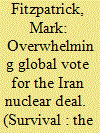

|
|
|
|
|
| Publication |
2014.
|
| Summary/Abstract |
One thing that is clear about the interim nuclear deal with Iran, reached on 24 November in Geneva, is that much of the world supports it. Nearly 70 nations have expressed that support formally. Nations liked that it capped Iran's programme, averted prospects for war, and showed light at the end of the sanctions tunnel. When members of the US Congress talk about legislating what a final deal with Iran must achieve, they ought to consider that the other parties to the negotiation also have a vote.
|
|
|
|
|
|
|
|
|
|
|
|
|
|
|
|
| 9 |
ID:
134051
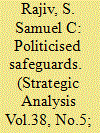

|
|
|
|
|
| Publication |
2014.
|
| Summary/Abstract |
This article examines Iranian contentions on three issue areas that exemplify the politicised nature of its interactions with the International Atomic Energy Agency (IAEA). These include access to military facilities, information credibility and the 'nuclear activism' of US-based non-governmental organisations (NGOs). Three drivers account for the emergence of such contentions: (1) multilateral and unilateral sanctions; (2) extended lack of progress at multilateral negotiating forums like the P5+1 and the E3/EU; and (3) organisational dynamics primarily related to the deterioration in Iran's interactions with the IAEA in the aftermath of the election of Yukiya Amano as the IAEA Director General (DG). Changes in dynamics in one or more of these factors, on the back of changes in domestic political leaderships (primarily in the US and Iran) and consequent modifications in their respective policy positions, have led to mutually agreeable outcomes like the November 2013 Joint Plan of Action (JPOA). In the context of 'politicised safeguards' losing some of their edge in the aftermath of the JPOA, the article closes by briefly examining the prospects of the IAEA drawing a 'broader [safeguards] conclusion' for Iran amidst the significant challenges that still need to be addressed.
|
|
|
|
|
|
|
|
|
|
|
|
|
|
|
|
| 10 |
ID:
153823
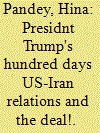

|
|
|
| 11 |
ID:
131453
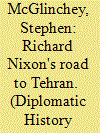

|
|
|
|
|
| Publication |
2013.
|
| Summary/Abstract |
By the time of Richard Nixon's arrival in office Iran had already become America's single largest arms purchaser. This was the result of an evolutionary process that had been underway for two decades. Nixon did not just change that evolutionary pattern of arms sales with Iran, he completely revised U.S. thinking on Iran's regional role. By the end of his first term in office, Nixon had leveraged U.S. Middle Eastern regional policy primarily around the focal point of a militarily strong, pro-U.S. Iran. In concert, the shah was encouraged to begin an unprecedented military spending spree. Consequently, in mid-1972 following a meeting of the two leaders in Tehran, Iranian annual purchases went, virtually overnight, from being measured in the tens of millions to being measured in the multi-billions. Tracing the complex evolution toward that meeting, and the accompanying policy shifts, form an underappreciated part of Cold War history.
|
|
|
|
|
|
|
|
|
|
|
|
|
|
|
|
| 12 |
ID:
130931
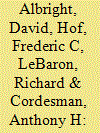

|
|
|
|
|
| Publication |
2014.
|
| Summary/Abstract |
In my 40 years in the region, I can't remember so many big front-page issues. Egypt, Syria, Iraq, Afghanistan and Iran. All are major problems at the same time, and there are lots of doubts about the U.S. role. Traditional allies are expressing concern and in some cases anger, wondering if the United States is actually a reliable ally. Today's topic lies at the heart of many of these concerns. We are very fortunate to have with us today a panel of true Middle East experts who have real-time, on-the-ground experience in the region.
|
|
|
|
|
|
|
|
|
|
|
|
|
|
|
|
| 13 |
ID:
129879
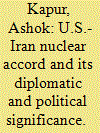

|
|
|
| 14 |
ID:
118253
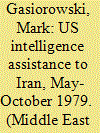

|
|
|
|
|
|
|
|